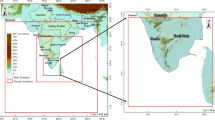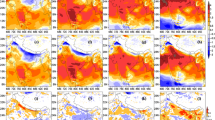Abstract
The ensemble prediction system (EPS) is widely used in research and at operation center because it can represent the uncertainty of predicted atmospheric state and provide information of probabilities. The high-resolution (so-called “convection-permitting”) limited area EPS can represent the convection and turbulence related to precipitation phenomena in more detail, but it is also much sensitive to small-scale or sub-grid scale processes. The convection and turbulence are represented using physical processes in the model and model errors occur due to sub-grid scale processes that were not resolved. This study examined the effect of considering sub-grid scale uncertainties using the high-resolution limited area EPS of the Korea Meteorological Administration (KMA). The developed EPS has horizontal resolution of 3 km and 12 ensemble members. The initial and boundary conditions were provided by the global model. The Random Parameters (RP) scheme was used to represent sub-grid scale uncertainties. The EPSs with and without the RP scheme were developed and the results were compared. During the one month period of July, 2013, a significant difference was shown in the spread of 1.5 m temperature and the Root Mean Square Error and spread of 10 m zonal wind due to application of the RP scheme. For precipitation forecast, the precipitation tended to be overestimated relative to the observation when the RP scheme was applied. Moreover, the forecast became more accurate for heavy precipitations and the longer forecast lead times. For two heavy rainfall cases occurred during the research period, the higher Equitable Threat Score was observed for heavy precipitations in the system with the RP scheme compared to the one without, demonstrating consistency with the statistical results for the research period. Therefore, the predictability for heavy precipitation phenomena that affected the Korean Peninsula increases if the RP scheme is used to consider sub-grid scale uncertainties in forecasting precipitation phenomena using the high-resolution limited area EPS of KMA.











Similar content being viewed by others
References
Baker, L. H., Rudd, A. C., Migliorini, S., & Bannister, R. N. (2014). Representation of model error in a convective-scale ensemble prediction system. Nonlinear Processes in Geophysics, 21, 19–39. doi:10.5194/npg-21-19-2014.
Barker, T. W. (1991). The relationship between spread and forecast error in extended-range forecasts. Journal of Climate, 4, 733–742. doi:10.1175/1520-0442(1991)004<0733:TRBSAF>2.0.CO;2.
Bornemann, J., Field, P., Furtado, K., & Weeks, M. (2013). The effect of ice fall speed in the structure of surface precipitation. 10th International SRNWP-Workshop on Non-Hydrostatic Modelling, Offenbach, Germany. http://srnwp.met.hu/workshops/Offenbach_2013/34Bornemann_IceFallSpeed_final.pdf.
Bouallègue, Z. B., Theis, S. E., & Gebhardt, C. (2013). Enhancing COSMO-DE ensemble forecasts by inexpensive techniques. Meteorologische Zeitschrift, 22, 49–59. doi:10.1127/0941-2948/2013/0374.
Bouttier, F., Vié, B., Nuissier, O., & Raynaud, L. (2012). Impact of stochastic physics in a convection-permitting ensemble. Monthly Weather Review, 140, 3706–3721. doi:10.1175/MWR-D-12-00031.1.
Bowler, N. E., Arribas, A., Mylne, K. R., Robertson, K. B., & Beare, S. E. (2008). The MOGREPS short-range ensemble prediction system. Quarterly Journal of the Royal Meteorological Society, 134, 703–722. doi:10.1002/qj.234.
Brier, G. W. (1950). Verification of forecasts expressed in terms of probability. Monthly Weather Review, 78, 1–3. doi:10.1175/1520-0493(1950)078<0001:VOFEIT>2.0.CO;2.
Caron, J.-F. (2013). Mismatching perturbations at the lateral boundaries in limited-area ensemble forecasting: A case study. Monthly Weather Review, 141, 356–374. doi:10.1175/MWR-D-12-00051.1.
Chien, F.-C., & Jou, B. J.-D. (2004). MM5 ensemble mean precipitation forecasts in the Taiwan area for three early summer convective (Mei-Yu) seasons. Weather and Forecasting, 19, 735–750. doi:10.1175/1520-0434(2004)019<0735:mempfi>2.0.co;2.
Davies, T. (2014). Lateral boundary conditions for limited area models. Quarterly Journal of the Royal Meteorological Society, 140, 185–196. doi:10.1002/qj.2127.
Davies, T., Cullen, M. J. P., Malcolm, A. J., Mawson, M. H., Staniforth, A., White, A. A., et al. (2005). A new dynamical core for the Met Office’s global and regional modelling of the atmosphere. Quarterly Journal of the Royal Meteorological Society, 131, 1759–1782. doi:10.1256/qj.04.101.
Ebert, E. E. (2001). Ability of a poor man’s ensemble to predict the probability and distribution of precipitation. Monthly Weather Review, 129, 2461–2480. doi:10.1175/1520-0493(2001)129<2461:AOAPMS>2.0.CO;2.
Ebert, E. E. (2008). Fuzzy verification of high-resolution gridded forecasts: a review and proposed framework. Meteorological Applications, 15, 51–64. doi:10.1002/met.25.
Fritsch, J. M., & Carbone, R. E. (2004). Improving quantitative precipitation forecasts in the warm season: A USWRP research and development strategy. Bulletin of the American Meteorological Society, 85, 955–965. doi:10.1175/BAMS-85-7-955.
Gebhardt, C., Theis, S. E., Paulat, M., & Ben Bouallègue, Z. (2011). Uncertainties in COSMO-DE precipitation forecasts introduced by model perturbations and variation of lateral boundaries. Atmospheric Research, 100, 168–177. doi:10.1016/j.atmosres.2010.12.008.
Gregory, D., & Rowntree, P. R. (1990). A mass flux convection scheme with representation of cloud ensemble characteristics and stability-dependent closure. Monthly Weather Review, 118, 1483–1506. doi:10.1175/1520-0493(1990)118<1483:AMFCSW>2.0.CO;2.
Hou, D., Kalnay, E., & Droegemeier, K. K. (2001). Objective verification of the SAMEX’98 ensemble forecasts. Monthly Weather Review, 129, 73–91. doi:10.1175/1520-0493(2001)129<0073:OVOTSE>2.0.CO;2.
Jones, M. S., Colle, B. A., & Tongue, J. S. (2007). Evaluation of a mesoscale short-range ensemble forecast system over the northeast United States. Weather and Forecasting, 22, 36–55. doi:10.1175/WAF973.1.
Kain, J. S., et al. (2008). Some practical considerations regarding horizontal resolution in the first generation of operational convection-allowing NWP. Weather and Forecasting, 23, 931–952. doi:10.1175/WAF2007106.1.
Kay, J. K., & Kim, H. M. (2014). Characteristics of initial perturbations in the ensemble prediction system of the Korea meteorological administration. Weather and Forecasting, 29, 563–581. doi:10.1175/WAF-D-13-00097.1.
Kay, J., Kim, H. M., Park, Y.-Y., & Son, J. (2013). Effect of doubling the ensemble size on the performance of ensemble prediction in the warm season using MOGREPS implemented at the KMA. Advances in Atmospheric Sciences, 30, 1287–1302. doi:10.1007/s00376-012-2083-y.
Kim, H. M., et al. (2014). Improvement of operating technique for numerical weather prediction model III. KMA Tech. Note, p. 150.
Kim, S., Kim, H. M., Kay, J. K., & Lee, S. W. (2015). Development and Evaluation of the High Resolution Limited Area Ensemble Prediction System in the Korea Meteorological Administration. Atmosphere, 25, 67–83.
Kühnlein, C., Keil, C., Craig, G. C., & Gebhardt, C. (2014). The impact of downscaled initial condition perturbations on convective-scale ensemble forecasts of precipitation. Quarterly Journal of the Royal Meteorological Society, 140, 1552–1562. doi:10.1002/qj.2238.
Lock, A. P., Brown, A. R., Bush, M. R., Martin, G. M., & Smith, R. N. B. (2000). A new boundary layer mixing scheme. Part I: Scheme description and single-column model tests. Monthly Weather Review, 128, 3187–3199. doi:10.1175/1520-0493(2000)128<3187:ANBLMS>2.0.CO;2.
Marsigli, C., Boccanera, F., Montani, A., & Paccagnella, T. (2005). The COSMO-LEPS mesoscale ensemble system: validation of the methodology and verification. Nonlinear Processes in Geophysics, 12, 527–536.
Montani, A., Cesari, D., Marsigli, C., & Paccagnella, T. (2011). Seven years of activity in the field of mesoscale ensemble forecasting by the COSMO-LEPS system: main achievements and open challenges. Tellus A, 63, 605–624. doi:10.1111/j.1600-0870.2010.00499.x.
Palmer, T. N., Barkmeijer, J., Buizza, R., & Petroliagis, T. (1997). The ECMWF ensemble prediction system. Meteorological Applications, 4, 301–304. doi:10.1017/S1350482797000649.
Peralta, C., Ben Bouallègue, Z., Theis, S. E., Gebhardt, C., & Buchhold, M. (2012). Accounting for initial condition uncertainties in COSMO-DE-EPS. Journal Geophysical Research, 117, D07108. doi:10.1029/2011JD016581.
Saito, K., Seko, H., Kunii, M., & Miyoshi T. (2012). Effect of lateral boundary perturbations on the breeding method and the local ensemble transform Kalman filter for mesoscale ensemble prediction. Tellus A, 64. doi:10.3402/tellusa.v64i0.11594.
Schaefer, J. T. (1990). The critical success index as an indicator of warning skill. Weather and Forecasting, 5, 570–575. doi:10.1175/1520-0434(1990)005<0570:TCSIAA>2.0.CO;2.
Schwartz, C. S., et al. (2009). Next-day convection-allowing WRF model guidance: A second look at 2-km versus 4-km grid spacing. Monthly Weather Review, 137, 3351–3372. doi:10.1175/2009MWR2924.1.
Shepard, D. (1968). A two-dimensional interpolation function for irregularly-spaced data. Proc. 23rd ACM National Conference, Association for Computing Machinery, 517–524.
Toth, Z., & Kalnay, E. (1997). Ensemble forecasting at NCEP and the breeding method. Monthly Weather Review, 125, 3297–3319. doi:10.1175/1520-0493(1997)125<3297:EFANAT>2.0.CO;2.
Vié, B., Nuissier, O., & Ducrocq, V. (2011). Cloud-resolving ensemble simulations of Mediterranean heavy precipitating events: uncertainty on initial conditions and lateral boundary conditions. Monthly Weather Review, 139, 403–423. doi:10.1175/2010mwr3487.1.
Webster, S., Brown, A. R., Cameron, D. R., & Jones, C. P. (2003). Improvements to the representation of orography in the Met Office Unified Model. Quarterly Journal of the Royal Meteorological Society, 129, 1989–2010. doi:10.1256/qj.02.133.
Weisman, M. L., Davis, C., Wang, W., Manning, K. W., & Klemp, J. B. (2008). Experiences with 0–36-h explicit convective forecasts with the WRF-ARW model. Weather and Forecasting, 23, 407–437. doi:10.1175/2007WAF2007005.1.
Wilks, D. S. (2006). Statistical methods in the atmospheric sciences (2nd ed.). London: Academic Press.
Wilson, D. R., & Ballard, S. P. (1999). A microphysically based precipitation scheme for the UK Meteorological Office Unified Model. Quarterly Journal of the Royal Meteorological Society, 125, 1607–1636. doi:10.1002/qj.49712555707.
Acknowledgements
The authors appreciate two reviewers for their valuable comments. This study was supported by the Korea Meteorological Administration Research and Development Program under Grant KMIPA 2015-5200. The authors appreciate the Numerical Weather Prediction Division of the Korea Meteorological Administration for providing computer facility support and resources for this study.
Author information
Authors and Affiliations
Corresponding author
Rights and permissions
About this article
Cite this article
Kim, S., Kim, H.M. Effect of Considering Sub-Grid Scale Uncertainties on the Forecasts of a High-Resolution Limited Area Ensemble Prediction System. Pure Appl. Geophys. 174, 2021–2037 (2017). https://doi.org/10.1007/s00024-017-1513-2
Received:
Revised:
Accepted:
Published:
Issue Date:
DOI: https://doi.org/10.1007/s00024-017-1513-2




